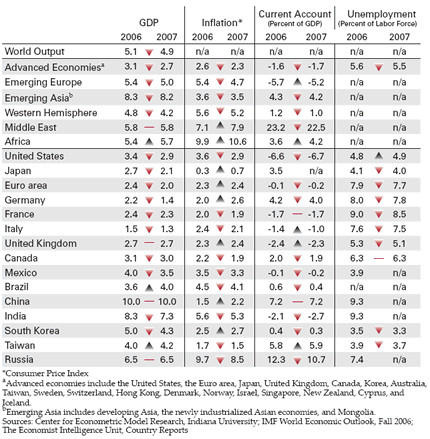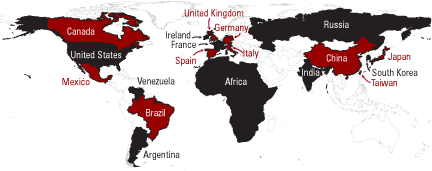The International Economy
Kelley School of Business, Indiana University, Bloomington
World economic growth for 2006 is projected at 5.1 percent (measured in terms of real GDP), compared to growth rates of 5.3 percent in 2004 and 4.9 percent in 2005. The International Monetary Fund in Washington forecasts world economic growth for 2007 at 4.9 percent; so global expansion is to continue for the fourth consecutive year at a level significantly above the historical trend of 3 percent.
While in the past economic output growth was strongly dependent on the performance of the U.S. economy, the forecast for 2007 predicts robust economic growth all around the world (see Table 1).
Table 1
World Output and Unemployment

Figure 1
Countries Discussed in the 2007 International Economy Outlook

Europe
The long awaited European recovery finally materialized in 2006. Corporate restructuring improved competitiveness and increased consumption and investment spending (particularly in France and Germany), contributing to the turnaround. Consumer confidence is robust. Real output growth is forecasted at 2 percent for 2007, compared to 2.4 percent in 2006.
A big question mark lingers over the effects of the 3 percent increase in Germany’s value-added tax in 2007 that might dampen consumer demand. As a net oil importer, the outlook depends significantly on future crude oil prices. Similar to U.S. house prices, housing prices in Spain, France, and Ireland are still elevated and a rapid downturn could cool off the economy.
Two long-term trends are alarming: first, productivity growth in most European countries has declined in recent years and jeopardizes future competitiveness in a global market. Second, economic fundamentals among member countries of the Euro area are drifting apart. While countries like Germany and France effectively managed an economic restructuring toward higher value-added production, other countries like Italy or Spain have been less successful. While per unit labor costs decreased in Germany and stayed more or less flat in France since the introduction of the euro, they have increased significantly in Italy and Spain. Over the long run, this might undermine the commitment to the Euro currency because depreciation might be too tempting for populist politicians.
The United Kingdom will do slightly better than continental Europe with an expected economic expansion of 2.7 percent. Job creation, consumption, and investment spending are robust and the economy expands around its potential output growth.
Far East
Japan’s economy is slowly recovering from deflation and is expected to grow a hearty 2.7 percent in 2006 and around 2.1 percent in 2007. The Bank of Japan has begun slowly redeeming excess liquidity and is expected to slightly increase interest rates in the year to come. However, it will be crucial not to increase rates too fast, as doing so would risk the economy falling back into deflation. The Japanese society is rapidly aging and the existing government debt burden of around 180 percent of GDP asks for a reduction of fiscal deficits and potentially future tax increases that might jeopardize economic growth.
While many experts expected a cooling down of the Chinese economy, the opposite has happened—it is growing even faster at around 10 percent in 2006, and the same is projected for 2007. With GDP well over $2 trillion, China is currently the worldwide economic growth engine. Trade relations are rapidly expanding with the United States, Europe, Japan, and other Asian neighbor countries.
India is expected to continue its outstanding growth performance, with an expected real growth rate of 8.3 percent in 2006 and a slightly lower 7.3 percent in 2007.
Overall, emerging Asia is doing particularly well and the area is expected to grow in 2007 by more than 8 percent. Intra-regional trade and capital flows are increasing dynamically. Several Asian economies—China, South Korea, Taiwan, and others—continued to buy dollars in the foreign exchange market in order to avoid an appreciation of their currencies and jeopardizing export-led growth. This contributes significantly to the worldwide current account imbalances. For the region, an overall current account surplus of 4.2 percent is projected for 2007. It is problematic, however, to determine how long these countries can pursue this strategy without sooner or later losing control over their domestic money supply and causing an unhealthy inflationary trend.
North America
The economies of the NAFTA members are increasingly integrated. Strong demand from the United States caused a further increase of Mexican and Canadian exports to America and contributes to a robust economic development in both countries. High commodity prices supported Canadian export performance. Both economies are expected to grow in real terms between 3 and 3.5 percent in 2007.
Russia/East Europe
Russia and most Middle and East European countries are continuing to do well and the outlook is optimistic into 2007. The common explanation is the booming crude oil price. Such high current account surpluses are not easy to manage and Russian inflation is creeping toward an expected 9.7 percent in 2006, slightly lower than what is predicted for 2007.
Latin America
Latin America is expected to see output growth of 4.8 percent in 2006 and 4.2 percent in 2007. Compared to Asian emerging countries, however, this growth rate is modest. The accelerated world market integration continues; the regional current account is expected to remain in modest surplus, although the Brazilian currency (the real) has significantly appreciated against the U.S. dollar and the euro. This is caused by large capital inflows that make it easier to finance and restructure the still significant government debt. In Argentina and Venezuela, inflation has reached double-digit levels and several populist governments in the region seem to deviate more and more from the best economic practices.
The Risks
High oil prices are the biggest risk for world economic activity in 2007. A rapid price increase would have significant negative effects for all oil-importing economies.
Rising current account imbalances are a second concern for the world economy. The U.S. current account for the first six months of 2006 reached a deficit of $431 billion and will probably reach 7 percent of GDP at the end of the year, while other regions, such as emerging Asia, Japan, and oil-exporting countries, further increase their current account surpluses. Over the long run, this is not sustainable and unavoidable adjustments will be made. The question is how smoothly these adjustments will occur. A fast and significant depreciation of the U.S. dollar would not hurt the U.S. economy as much as it would hurt China and other big exporters to the U.S. market.
Private capital is increasingly flowing from the developed world into emerging economies, causing the yield spreads of emerging countries’ debt to decline. These low-risk spreads seem—at least in some cases—unaligned with economic fundamentals. A financial crisis in one country could trigger a domino effect and a rapid turnaround of worldwide capital flows.
Notes
- International Monetary Fund, World Economic Outlook: Financial Systems and Economic Cycles, September 2006. Available at www.imf.org/external/pubs/ft/weo/2006/02/index.htm.
Also in this Issue…
- Outlook for 2007
- The International Economy
- The U.S. Economy
- Financial Forecast
- Housing
- Indiana Agriculture
- Indiana
- Anderson and Muncie
- Bloomington
- Columbus
- Evansville
- Fort Wayne
- Gary
- Indianapolis
- Kokomo
- New Albany
- Richmond
- South Bend and Elkhart-Goshen
- Terre Haute
- Indiana Metro Economies at a Glance
- Return to Table of Contents



